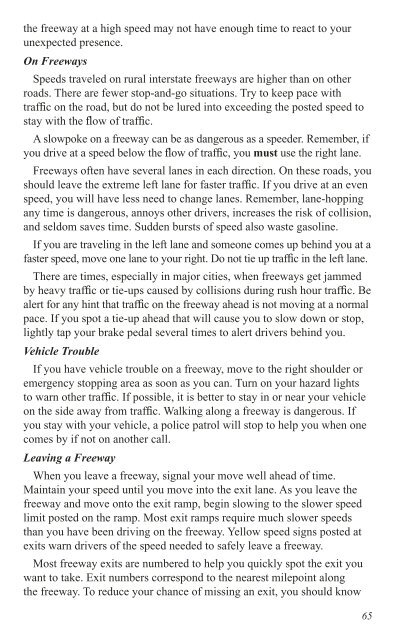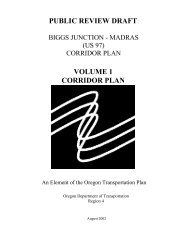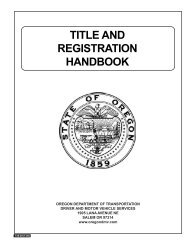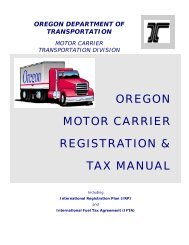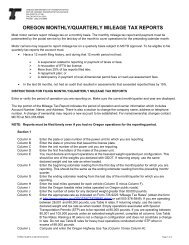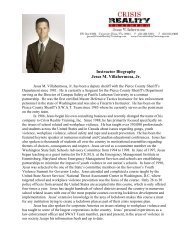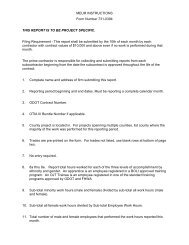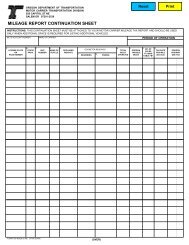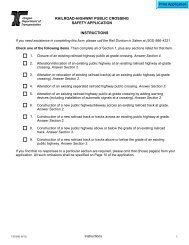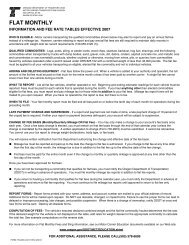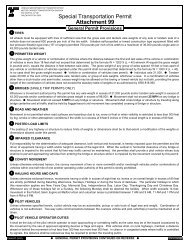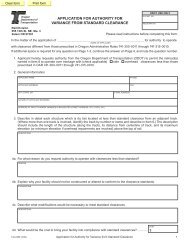2013 Oregon Driver Manual - Oregon Department of Transportation
2013 Oregon Driver Manual - Oregon Department of Transportation
2013 Oregon Driver Manual - Oregon Department of Transportation
Create successful ePaper yourself
Turn your PDF publications into a flip-book with our unique Google optimized e-Paper software.
the freeway at a high speed may not have enough time to react to your<br />
unexpected presence.<br />
On Freeways<br />
Speeds traveled on rural interstate freeways are higher than on other<br />
roads. There are fewer stop-and-go situations. Try to keep pace with<br />
traffi c on the road, but do not be lured into exceeding the posted speed to<br />
stay with the fl ow <strong>of</strong> traffi c.<br />
A slowpoke on a freeway can be as dangerous as a speeder. Remember, if<br />
you drive at a speed below the fl ow <strong>of</strong> traffi c, you must use the right lane.<br />
Freeways <strong>of</strong>ten have several lanes in each direction. On these roads, you<br />
should leave the extreme left lane for faster traffi c. If you drive at an even<br />
speed, you will have less need to change lanes. Remember, lane-hopping<br />
any time is dangerous, annoys other drivers, increases the risk <strong>of</strong> collision,<br />
and seldom saves time. Sudden bursts <strong>of</strong> speed also waste gasoline.<br />
If you are traveling in the left lane and someone comes up behind you at a<br />
faster speed, move one lane to your right. Do not tie up traffi c in the left lane.<br />
There are times, especially in major cities, when freeways get jammed<br />
by heavy traffi c or tie-ups caused by collisions during rush hour traffi c. Be<br />
alert for any hint that traffi c on the freeway ahead is not moving at a normal<br />
pace. If you spot a tie-up ahead that will cause you to slow down or stop,<br />
lightly tap your brake pedal several times to alert drivers behind you.<br />
Vehicle Trouble<br />
If you have vehicle trouble on a freeway, move to the right shoulder or<br />
emergency stopping area as soon as you can. Turn on your hazard lights<br />
to warn other traffi c. If possible, it is better to stay in or near your vehicle<br />
on the side away from traffi c. Walking along a freeway is dangerous. If<br />
you stay with your vehicle, a police patrol will stop to help you when one<br />
comes by if not on another call.<br />
Leaving a Freeway<br />
When you leave a freeway, signal your move well ahead <strong>of</strong> time.<br />
Maintain your speed until you move into the exit lane. As you leave the<br />
freeway and move onto the exit ramp, begin slowing to the slower speed<br />
limit posted on the ramp. Most exit ramps require much slower speeds<br />
than you have been driving on the freeway. Yellow speed signs posted at<br />
exits warn drivers <strong>of</strong> the speed needed to safely leave a freeway.<br />
Most freeway exits are numbered to help you quickly spot the exit you<br />
want to take. Exit numbers correspond to the nearest milepoint along<br />
the freeway. To reduce your chance <strong>of</strong> missing an exit, you should know<br />
65


